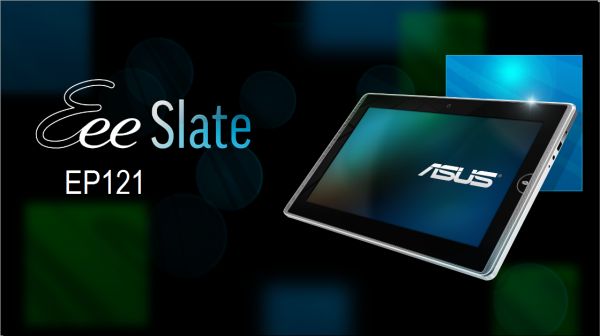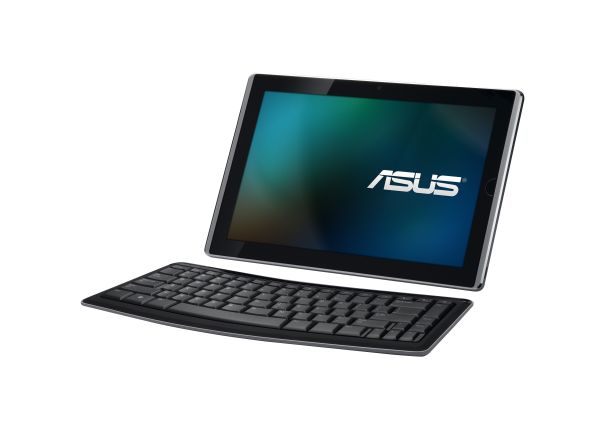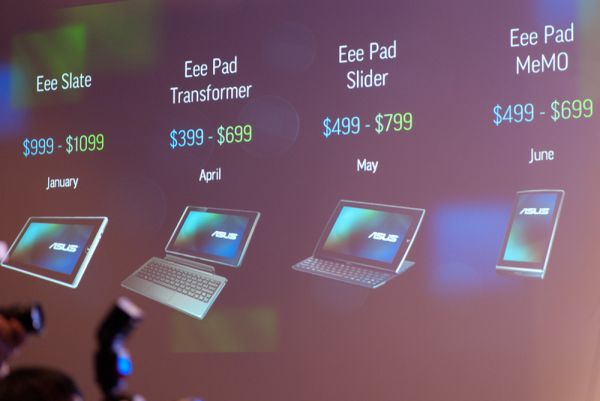ASUS Announces Eee Pad and Eee Slate Tablets
by Vivek Gowri on January 4, 2011 5:42 PM EST
And lastly, we have the Windows-based Eee Slate EP121 (I really don’t know where they come up with these names). There’s some history here, dating back to 2006 when ASUS first launched the R2h UMPC and R1F convertible tablet. They were ASUS’ first serious entry to the touchscreen PC market, and continued into the Eee PC T91 and T101 convertible netbooks. The Eee Pads and Eee Slate together will replace those.
The EP121 has Windows 7 Home Premium running on top of a Core i5-470UM, 2 or 4GB memory, and 32 or 64GB of flash storage. The 12.1” IPS panel has a 16:10 aspect ratio and WXGA resolution (1280x800), but most importantly features a Wacom active digitizer for pen-based handwriting recognition. The rest of the specs are pretty straightforward—a 2.0MP front facing camera, SDHC/SDXC card reader, one USB port, mini-HDMI, Bluetooth 3.0, and 2.4GHz 802.11n. A Bluetooth keyboard is included with the EP121; it looks to be a branded version of Microsoft’s Bluetooth Mobile Keyboard 6000.
In essence, the EP121 is a slate tablet PC with higher-end ultraportable internals. The combination of very respectable specs and the Wacom-enabled IPS display go a long way towards justifying the somewhat steep $999 cost, though given what HP is charging for its Atom-based 8.9” Slate ($799, to jog your memory), that figure looks almost reasonable. For $200 more, the ASUS has a lot more computing power and more features, though at 2.55lbs it’s a fair bit larger and heavier.
With that said, it’s still pretty thin and light, especially compared to some of the business-class convertible tablets on the market. I’m liking the overall package, since it balances power, portability, and price well along with the IPS display and Wacom digitizer. I think something that has gone mostly under the radar with the advent of tablets is the return of IPS displays in mobile computers—for a long time, IBM was the last one to offer IPS displays on their ThinkPad T series, but even they dumped the option in early 2007. Tablets are bringing IPS back, and that’s a very good thing.
The thing is, great specs or not, $999 is still a pretty hefty sum of money for a tablet, so I don’t forsee the EP121 making a huge sales dent. It’ll make a lot of sense for some users, like our smartphone editor Brian Klug, but it’s not really a tablet that can be recommended unless you want Windows and a Wacom digitizer. For a student looking for an ultraportable system, it looks like a very interesting option, and it’s definitely on the radar for inking fans, but at this point in time, I just don’t think that a Windows-based tablet solution is ideal for the majority of the tablet market. Either way, the Eee Slate should be available this quarter.
Wrap-Up
So that's the first CES salvo in what is sure to be a barrage of slate and tablet devices. ASUS is setting the standard with IPS displays across their lineup, which we'd love to see more of elsewhere. (Hint: we're tired of TN panel laptops!) The pricing looks reasonable, and the feature set is good as well. Perhaps the biggest drawback is that outside of the Slate, these are all targeting Q2/Q3 release dates, which means they're still a ways off from retail availability, but they might be worth the wait.













37 Comments
View All Comments
vol7ron - Tuesday, January 4, 2011 - link
As with all things computing, the success hinders on options and price. They have to give enough of the former and reduce enough of the later.True belief: pad/netbook devices need a smaller profit margin.
michael2k - Tuesday, January 4, 2011 - link
The high profit margin is the only reason that anyone is entering the market. Without the high profit margin, no one would introduce a single, let alone four, products.Let the early adopters pay the high margin if that is what concerns you.
MobiusStrip - Wednesday, January 5, 2011 - link
GPS. EVERY tablet should have GPS. Tablets are little more than a gimmick, but the addition of GPS would add solid value at very little cost to the manufacturer. Not to mention beating Apple, which irritatingly omitted GPS from half the iPads.Any vendor that fails to take this obvious step doesn't deserve your dollars, and their products aren't going to be around long anyway.
tipoo - Tuesday, January 4, 2011 - link
On the spec sheet next to battery life they probably just write "No".JarredWalton - Tuesday, January 4, 2011 - link
Except we got pretty good battery life from the ASUS U30Jc, and the UL80Jt, and.... It will depend on how big the battery is, but the i5-470UM ought to be able to hit at least five hours on a ~30Wh battery.VivekGowri - Tuesday, January 4, 2011 - link
Yeah, they didn't actually mention battery life, indicating that it's probably not very good.....Unfortunate, but it's a reality. I think Windows slates are going to be doomed to mediocre battery life - Intel chips aren't low-power enough for tablets (yet). That'll change with Moorestown and Oak Trail, but right now they just can't compete with ARM as far as handheld battery life.halcyon - Wednesday, January 5, 2011 - link
Well, Asus pretty much wrote "no" in the specs of Eee Slate EP121:Battery life: up to 3 hours (under specific conditions, which you can easily guess what those are)
In real life usage that is going to mean less than 2 hours of battery life.
If that is not a FAIL for a tablet, I don't know what is.
tipoo - Wednesday, January 5, 2011 - link
Yeah, three hours is what I would consider bad in a laptop, let alone a tablet.headbox - Tuesday, January 4, 2011 - link
I predict Zune-like sales if they're lucky.bplewis24 - Tuesday, January 4, 2011 - link
Anybody else find it interesting that Asus is going with IPS displays across the board here when they generally do not use IPS displays in their mainstream desktop monitor line of products?Does this signify a shift in focus that will carry over to their desktop monitors or will it be exclusive to their tablet/slate product line?
Brandon